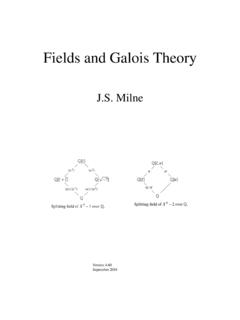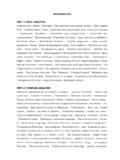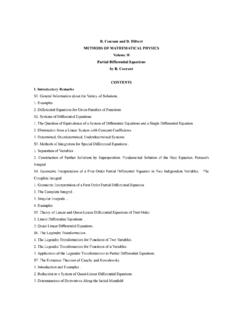Transcription of MATRICES - Department of Mathematics
1 1 matrices After studying this chapter you will acquire the skills in knowledge on MATRICES Knowledge on matrix operations. Matrix as a tool of solving linear equations with two or three unknowns. List of References: Frank Ayres, JR, Theory and Problems of MATRICES Sohaum s Outline Series Datta KB , Matrix and Linear Algebra Vatssa BS, Theory of MATRICES , second Revise Edition Cooray TMJA, Advance Mathematics for Engineers, Chapter 1- 4 Chapter I: Introduction of MATRICES Definition 1: A rectangular arrangement of mn numbers, in m rows and n columns and enclosed within a bracket is called a matrix. We shall denote MATRICES by capital letters as A,B, C etc. A is a matrix of order m n. ith row jth column element of the matrix denoted by Remark: A matrix is not just a collection of elements but every element has assigned a definite position in a particular row and column.
2 Special Types of MATRICES : 1. Square matrix: A matrix in which numbers of rows are equal to number of columns is called a square matrix. Example: 2. Diagonal matrix: A square matrix A = is called a diagonal matrix if each of its non-diagonal element is zero. 2 That is and at least one element. Example: 3. Identity Matrix A diagonal matrix whose diagonal elements are equal to 1 is called identity matrix and denoted by. That is Example: 4. Upper Triangular matrix: A square matrix said to be a Upper triangular matrix if . Example: 5. Lower Triangular Matrix: A square matrix said to be a Lower triangular matrix if . Example: 6. Symmetric Matrix: A square matrix A = said to be a symmetric if for all i and j. Example: 3 7. Skew- Symmetric Matrix: A square matrix A = said to be a skew-symmetric if for all i and j. Example: 8. Zero Matrix: A matrix whose all elements are zero is called as Zero Matrix and order Zero matrix denoted by.
3 Example: 9. Row Vector A matrix consists a single row is called as a row vector or row matrix. Example: 10. Column Vector A matrix consists a single column is called a column vector or column matrix. Example: Chapter 2: Matrix Algebra Equality of two MATRICES : Two MATRICES A and B are said to be equal if (i) They are of same order. (ii) Their corresponding elements are equal. That is if A = then for all i and j. 4 Scalar multiple of a matrix Let k be a scalar then scalar product of matrix A = given denoted by kA and given by kA = or Addition of two MATRICES : Let A = and are two MATRICES with same order then sum of the two MATRICES are given by Example : let and . Find (i) 5B (ii) A + B (iii) 4A 2B (iv) 0 A Multiplication of two MATRICES : Two MATRICES A and B are said to be confirmable for product AB if number of columns in A equals to the number of rows in matrix B.
4 Let A = be two MATRICES the product matrix C= AB, is matrix of order m r where Example : Let and Calculate (i) AB (ii) BA (iii) is AB = BA ? Integral power of MATRICES : Let A be a square matrix of order n, and m be positive integer then we define (m times multiplication) Properties of the MATRICES Let A, B and C are three MATRICES and are scalars then (i) Associative Law 5 (ii) Distributive law (iii) Associative Law (iv) Associative Law (v) Associative Law (vi) Distributive law Transpose: The transpose of matrix A = , written ( is the matrix obtained by writing the rows of A in order as columns. That is . Properties of Transpose: (i) (ii) = A (iii) = k for scalar k. (iv) Example : Using the following MATRICES A and B, Verify the transpose properties , Proof: (i) Let and are the element of the matrix A and B respectively.)
5 Then is the element of matrix and it is element of the matrix Also and are the element of the matrix and respectively. Therefore is the element of the matrix + (ii) Let element of the matrix A is, it is element of the then it is element of the matrix (iii) try (iv) is the element of the AB It is result of the multiplication of the ith row and kth column and it is element of the matrix . , element is the multiplication of kth row of with ith column of , That is kth column of B with ith row of A. 6 A square matrix A is said to be symmetric if . Example: , A is symmetric by the definition of symmetric matrix. Then That is A square matrix A is said to be skew- symmetric if Example: (i) and are both symmetric. (ii) is a symmetric matrix. (iii) is a skew-symmetric matrix. (iv) If A is a symmetric matrix and m is any positive integer then is also symmetric.
6 (v) If A is skew symmetric matrix then odd integral powers of A is skew symmetric, while positive even integral powers of A is symmetric. If A and B are symmetric MATRICES then (vi) is symmetric. (vii) is skew-symmetric. Exercise : Verify the (i) , (ii) and (iii) using the following matrix A. Chapter 3: Determinant, Minor and Adjoint MATRICES Definition : Let A = be a square matrix of order n , then the number called determinant of the matrix A. (i) Determinant of 2 2 matrix 7 Let A= then = = (ii) Determinant of 3 3 matrix Let B = Then = Exercise : Calculate the determinants of the following MATRICES (i) (ii) Properties of the Determinant: a. The determinant of a matrix A and its transpose are equal. b. Let A be a square matrix (i) If A has a row (column) of zeros then (ii) If A has two identical rows ( or columns) then c. If A is triangular matrix then is product of the diagonal elements.
7 D. If A is a square matrix of order n and k is a scalar then Singular Matrix If A is square matrix of order n, the A is called singular matrix when and non- singular otherwise. Minor and Cofactors: Let A = is a square matrix. Then denote a sub matrix of A with order (n-1) (n-1) obtained by deleting its row and column. The determinant is called the minor of the element of A. The cofactor of denoted by and is equal to. Exercise : Let (i) Compute determinant of A. 8 (ii) Find the cofactor matrix. Adjoin Matrix: The transpose of the matrix of cofactors of the element of A denoted by is called adjoin of matrix A. Example : Find the adjoin matrix of the above example. Theorem : For any square matrix A, where I is the identity matrix of same order. Proof: Let A = Since A is a square matrix of order n, then also in same order.
8 Consider then Now consider the product ( as we know that and when ) 9 Where is unit matrix of order n. Theorem : If A is a non-singular matrix of order n, then . Proof: By the theorem 1 Theorem : If A and B are two square MATRICES of order n then Proof: By the theorem 1 Therefore Consider, .. (i) Also consider .. (ii) 10 Therefore from (i) and (ii) we conclude that Some results of adjoint (i) For any square matrix A (ii) The adjoint of an identity matrix is the identity matrix. (iii) The adjoint of a symmetric matrix is a symmetric matrix..Chapter 4: Inverse of a Matrix and Elementary Row Operations Inverse of a Matrix Definition : If A and B are two MATRICES such that , then each is said to be inverse of the other.
9 The inverse of A is denoted by . Theorem : (Existence of the Inverse) The necessary and sufficient condition for a square matrix A to have an inverse is that (That is A is non singular). Proof: (i) The necessary condition Let A be a square matrix of order n and B is inverse of it, then Therefore. (ii) The sufficient condition: If , the we define the matrix B such that Then = Similarly = Thus hence B is inverse of A and is given by Theorem : (Uniqueness of the Inverse) Inverse of a matrix if it exists is unique. 11 Proof: Let B and C are inverse s of the matrix A then and Example 6: Let find Theorem : (Reversal law of the inverse of product) If A and B are two non-singular MATRICES of order n, then (AB) is also non singular and . Proof: Since A and B are non-singular , therefore, then.
10 Consider ..(1) Similarly ..(2) From (1) and (2) = Therefore by the definition and uniqueness of the inverse : If are non singular MATRICES of order n, then . Theorem : If A is a non-singular matrix of order n then . Proof: Since therefore the matrix is non-singular and exists. Let Taking transpose on both sides we get Therefore 12 That is . Theorem : If A is a non-singular matrix , k is non zero scalar, then . Proof: Since A is non-singular matrix exits. Let consider Therefore is inverse of By uniqueness if inverse Theorem : If A is a non-singular matrix then . Proof: Since A is non-singular matrix, exits and we have Therefore Then Elementary Transformations: Some operations on MATRICES called as elementary transformations. There are six types of elementary transformations, three of then are row transformations and other three of them are column transformations.





